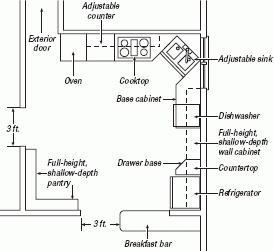Life on Wheels (95 page)
Authors: Gary Karp
Tags: #Health & Fitness, #Physical Impairments, #Juvenile Nonfiction, #Health & Daily Living, #Medical, #Physical Medicine & Rehabilitation, #Physiology, #Philosophy, #General

Use windowed doors to save the need to search for items by opening many cabinets.

Remove cabinet doors altogether, particularly on lower cabinets, where you have to move away from the door as you open it.

Put the most-often used items on shelves that are easiest to reach.

Use a grabber arm to get items on shelves that are out of reach (see
Figure 7-9
).

Adjust cabinet shelves to a more convenient configuration.

Store more items on the counter. A small stack of shelves can make good use of a countertop, or small cabinets with doors can be built in.

Place a lazy Susan in a cabinet or on a countertop.

Move overhead cabinets lower to bring them into easier reach.

Install automated units that can be lowered to counter level.
Drawers bring objects within reach and view and into the light. The back half is as useful as the front, unlike a cabinet. Use roller tracks that glide easily, and do not overload the drawer with heavy items that will make the drawer harder to slide in and out. Provide handles that don’t demand fine dexterity or strong grip. Cloth loops added to handles can help people with no grip open drawers. Be sure there is room for the wheelchair next to the drawer. It is not necessary to reach every shelf in every cabinet in your kitchen. Louis Tenenbaum observes:
My experience in the kitchen is that we use a whole lot fewer things than we have. What it’s really about is spending the time to figure out what things you need to have close by. In many cases, the things you don’t have close by, you use rarely. For stuff that you only use when you have company, wait until your guests arrive, and ask them to get it down.
Kitchen Electrical Issues
Switches and power outlets are typically placed on walls at the back of counters. These are especially difficult to reach in corners of L-shaped or U-shaped layouts. Outlets can be relocated to the front of floor cabinets or just under the surface if there is an open space for leg room. A switch or outlet box can be placed underneath a surface where leg room has been provided, taking care to put it to the side so that it does not obstruct or potentially injure your legs. There is some risk at this location of a cord getting caught by an arm or your chair, or grabbed by a curious child and of an appliance being pulled off the counter. Many kitchens have false panels, particularly underneath the sink, where a hole could be cut and wiring extended to install an outlet.
Figure 7-9 Using a grabber arm for a high cabinet.

Another option is to place power underneath overhead cabinets—which also keeps them beyond the reach of children. A cable raceway can run underneath the front edge of upper cabinets, providing a series of outlets along its length.
Most kitchens benefit from lighting placed underneath upper cabinets. These lights make counter tasks easier to see and also bring light switches within reach. Choose fixtures that will not create glare or shine directly in your eyes from the seated angle. Natural light is appealing in a kitchen, so provide window shade controls that can be reached from the seated position.
Kitchen Layouts
The most efficient layout for a kitchen is a U-shape, which puts more surface within reach without a user having to move. A drawback is that deeper spaces in the corners are more difficult to reach. The U-shape layout also makes it easier to provide room for you to fully turn around in your chair.
A kitchen with two longer parallel surfaces has its advantages, too. If the kitchen is properly arranged, you can be within reach of surfaces and facilities on either side of you and have a pull-out surface installed at a good height for cutting and food handling. It is critical to establish good relationships among all features of the kitchen and make the best use of accessories. This layout also allows you to enter or leave the working area from either end. Figure 7-10 shows an example of a good option for a kitchen layout.
Figure 7-10 An L-shaped kitchen.

If you need to make do in a kitchen with major appliances that are difficult to use, don’t discount the value of your local appliance store. Toaster ovens, crock pots, waffle irons, griddles, rice cookers, and hot plates are lightweight, easily positioned, inexpensive, and energy efficient.
Other books
Aftershocks by Harry Turtledove
Luck of the Wolf by Susan Krinard
Murder at Moot Point by Marlys Millhiser
Devil's Lair by David Wisehart
I Heart Paris by Lindsey Kelk
Parker 01 - The Mark by Pinter, Jason
Once Written, Twice Shy (The Broken Men Chronicles) by Decevito, Carey
Emanare (Destined, #1) by Browning, Taryn
Infidelities by Kirsty Gunn
Taken In The Night: Bred in Darkness Episode One by Knight, Victoria